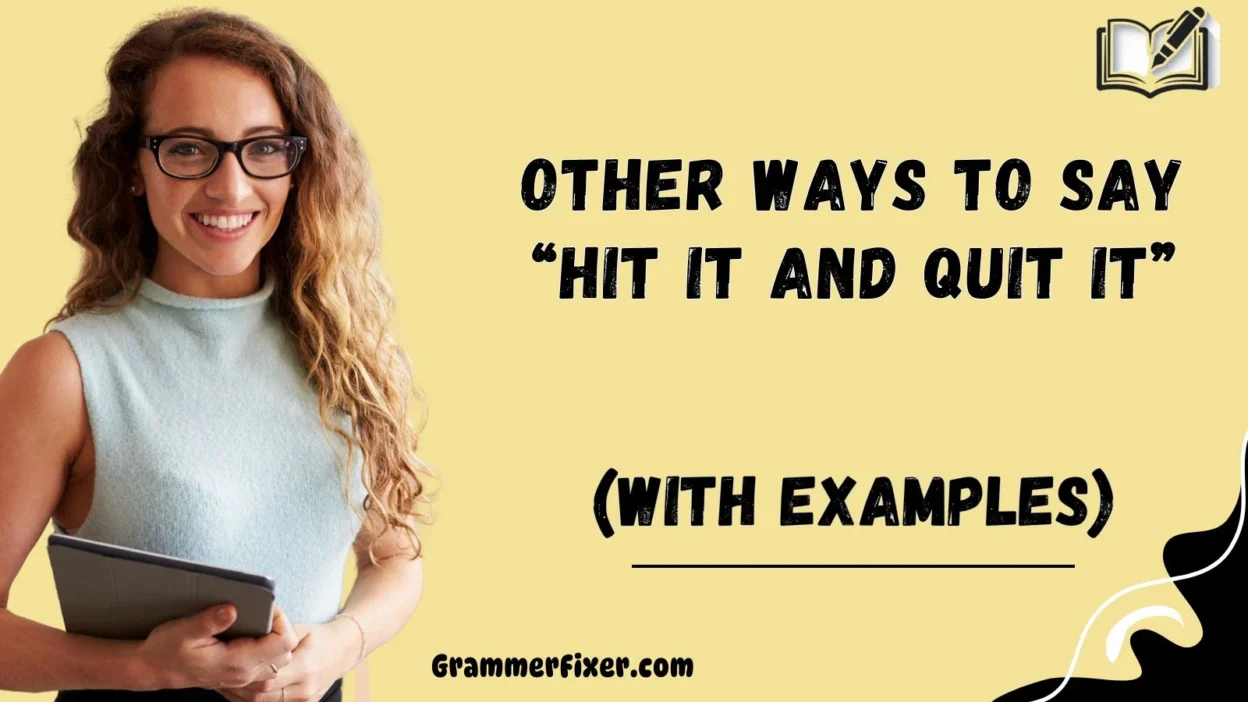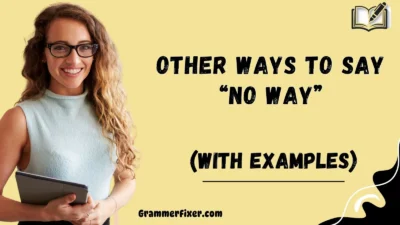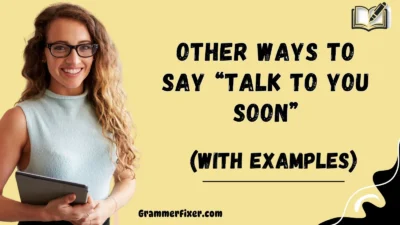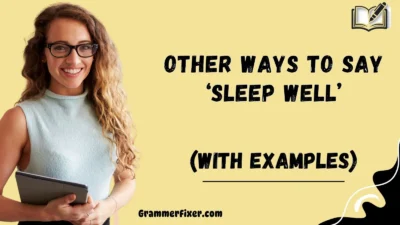Finding the right words matters—especially when talking about topics as sensitive as intimacy, relationships, and personal connections. The phrase “hit it and quit it” is a slang term that can often sound crude, dismissive, and disrespectful. For people who want to communicate with more warmth, care, and empathy, it helps to have alternative expressions that acknowledge consent, respect, and emotional nuance.
This guide explores 30 thoughtful alternatives, along with their meanings, tones, and examples. Whether you’re aiming to avoid objectifying language, or you simply want more mindful word choices, these options can help you speak with more respect and clarity.
What Does “Hit It and Quit It” Mean?
The phrase “hit it and quit it” is a slang expression referring to a casual sexual encounter followed by an immediate departure, often implying a lack of commitment or emotional involvement. It tends to carry negative undertones of objectification, carelessness, and disregard for the partner.
When to Use “Hit It and Quit It”?
While the phrase is commonly understood, it’s best reserved for informal conversations where a slang tone is acceptable. It may be used in casual discussions among friends or in pop culture references, but it is not suitable for professional, formal, or respectful conversations about intimacy.
Is It Professional/Polite to Say “Hit It and Quit It”?
No. The phrase is not professional and is rarely polite. It can come across as disrespectful, objectifying, and demeaning, especially in conversations about relationships or personal connections. Choosing more considerate alternatives shows awareness and respect for all parties involved.
Pros or Cons
Pros
- Widely recognized slang phrase
- Direct and clear in meaning
Cons
- Crude and offensive undertones
- Reinforces negative stereotypes about intimacy
- Can dehumanize partners by treating them as objects
- Not appropriate in thoughtful, respectful, or professional conversations
1. One-Night Stand
Meaning: A brief, single sexual encounter with no expectation of further relationship.
Detailed Explanation: Neutral but still direct, this phrase is widely recognized and less offensive.
Scenario Example: “They had a one-night stand while traveling abroad.”
Best Use: Informal but neutral conversations.
Worst Use: In professional discussions or when describing someone’s personal life disrespectfully.
Tone: Casual, descriptive.
2. Casual Hookup
Meaning: A casual sexual meeting without long-term commitment.
Detailed Explanation: A more respectful way to describe non-committal intimacy.
Scenario Example: “They agreed it was just a casual hookup, nothing more.”
Best Use: Everyday conversations, modern dating discussions.
Worst Use: When trying to describe a relationship that does involve emotional connection.
Tone: Neutral, contemporary.
3. Fling
Meaning: A short-lived romantic or sexual relationship.
Detailed Explanation: Softer and less crude than slang phrases, it acknowledges some emotional involvement.
Scenario Example: “It was just a summer fling.”
Best Use: Lighthearted, storytelling contexts.
Worst Use: When dismissing someone’s real feelings or minimizing deeper emotional impact.
Tone: Playful, casual.
4. Quickie
Meaning: A brief sexual encounter.
Detailed Explanation: Focuses on speed rather than emotional disconnection, though still casual.
Scenario Example: “They had a quickie before heading to work.”
Best Use: Informal, humorous contexts.
Worst Use: When discussing intimacy in serious or respectful conversations.
Tone: Playful, slangy.
5. Friends with Benefits
Meaning: Friendship that includes sexual intimacy without exclusivity.
Detailed Explanation: A clear and widely accepted term that centers mutual consent.
Scenario Example: “They’ve been friends with benefits for months.”
Best Use: Neutral, clear, respectful tone.
Worst Use: When one party is actually seeking a committed relationship.
Tone: Balanced, casual, consensual.
6. No-Strings-Attached Relationship
Meaning: A consensual arrangement without commitment or expectations.
Detailed Explanation: More formal and neutral, emphasizing clarity and consent.
Scenario Example: “They entered a no-strings-attached relationship to keep things simple.”
Best Use: Thoughtful, respectful conversations.
Worst Use: When discussing a situation where one partner secretly expects emotional commitment.
Tone: Neutral, mindful.
7. Casual Encounter
Meaning: A non-committal sexual meeting.
Detailed Explanation: Neutral language that avoids crude undertones.
Scenario Example: “Their casual encounter didn’t lead to anything serious.”
Best Use: Everyday discussions with neutral tone.
Worst Use: When referring to long-term or emotionally meaningful interactions.
Tone: Objective, descriptive.
8. Wham, Bam, Thank You, Ma’am
Meaning: A humorous, old-fashioned phrase describing a quick sexual encounter.
Detailed Explanation: Still somewhat disrespectful but lighter in tone.
Scenario Example: “It was just a wham, bam, thank you, ma’am situation.”
Best Use: Informal, joking settings among friends.
Worst Use: In serious or sensitive conversations where respect is expected.
Tone: Humorous, casual.
9. Love ’Em and Leave ’Em
Meaning: Pursuing someone briefly, then leaving without commitment.
Detailed Explanation: Suggests fleeting attraction but still can sound careless.
Scenario Example: “He has a reputation for loving ’em and leaving ’em.”
Best Use: Storytelling, cautionary tone.
Worst Use: When describing real-life relationships where emotions are involved.
Tone: Informal, cautionary.
10. Flash in the Pan
Meaning: Something brief, exciting, but without lasting value.
Detailed Explanation: A metaphorical, less sexualized option.
Scenario Example: “Their romance was just a flash in the pan.”
Best Use: Conversations about short-lived flings.
Worst Use: When you want to highlight intimacy specifically (can sound dismissive or minimizing).
Tone: Neutral, reflective.
11. Short-Lived Affair
Meaning: A brief romantic or sexual relationship that ended quickly.
Detailed Explanation: Formal, descriptive, and less slangy.
Scenario Example: “Their short-lived affair faded within weeks.”
Best Use: Writing, storytelling, or thoughtful conversations.
Worst Use: When used in judgmental or shaming tones about someone’s personal choices.
Tone: Neutral, respectful.
12. Casual Romance
Meaning: A light romantic connection without deep commitment.
Detailed Explanation: Softer phrasing that includes an element of attraction and care.
Scenario Example: “It was more of a casual romance than a relationship.”
Best Use: When you want to balance intimacy and romance without long-term expectations.
Worst Use: If the situation was strictly physical (this may sound misleading).
Tone: Gentle, positive.
13. Fleeting Passion
Meaning: An intense but short-lived connection.
Detailed Explanation: Evokes intensity and emotion while acknowledging impermanence.
Scenario Example: “Their time together was a fleeting passion.”
Best Use: Poetic or reflective conversations.
Worst Use: When trying to minimize or mock someone’s genuine feelings.
Tone: Passionate, thoughtful.
14. Whirlwind Romance
Meaning: A fast, intense relationship that ends quickly.
Detailed Explanation: Suggests excitement and emotional involvement, not just physical.
Scenario Example: “They had a whirlwind romance during the summer.”
Best Use: Romantic or storytelling contexts.
Worst Use: When referring to purely physical encounters.
Tone: Emotional, dramatic.
15. Brief Encounter
Meaning: A short meeting, often with emotional or physical intimacy.
Detailed Explanation: Neutral, polite, and somewhat literary.
Scenario Example: “Their brief encounter left lasting memories.”
Best Use: Neutral or professional storytelling settings.
Worst Use: If used sarcastically about sensitive personal relationships.
Tone: Neutral, descriptive.
16. Quick Fling
Meaning: A short, lighthearted romantic or sexual involvement.
Detailed Explanation: Suggests both speed and lack of commitment while being less crude.
Scenario Example: “They shared a quick fling during college.”
Best Use: Casual conversations about brief experiences.
Worst Use: When one party still has lingering emotions—it could feel dismissive.
Tone: Playful, casual.
17. Fly-by-Night Romance
Meaning: A relationship or affair that happens quickly and disappears just as fast.
Detailed Explanation: Emphasizes impermanence while sounding more colorful than clinical.
Scenario Example: “It was a fly-by-night romance that ended as soon as it started.”
Best Use: Storytelling or reflective contexts.
Worst Use: When used mockingly in serious conversations about intimacy.
Tone: Metaphorical, casual.
18. Casual Affair
Meaning: A relationship or sexual involvement without depth or long-term commitment.
Detailed Explanation: More formal than slang, with a straightforward tone.
Scenario Example: “They had a casual affair for a few months.”
Best Use: Descriptive, balanced tone for writing or conversation.
Worst Use: When judging or gossiping—it can sound accusatory.
Tone: Neutral, professional.
19. Brief Romance
Meaning: A romantic connection that ends quickly.
Detailed Explanation: Neutral and less judgmental, acknowledging affection.
Scenario Example: “Their brief romance blossomed during a holiday trip.”
Best Use: Conversations with emotional nuance.
Worst Use: Strictly physical encounters (it may give the wrong impression).
Tone: Gentle, empathetic.
20. Short-Term Relationship
Meaning: A relationship with clear limits in time or intention.
Detailed Explanation: Neutral phrasing, often used in dating contexts.
Scenario Example: “They entered a short-term relationship knowing it wouldn’t last.”
Best Use: Dating discussions, professional writing.
Worst Use: When minimizing someone’s genuine emotional investment.
Tone: Neutral, respectful.
21. Casual Connection
Meaning: A bond or intimacy without long-term expectations.
Detailed Explanation: A softer, more human-centered alternative.
Scenario Example: “They enjoyed a casual connection without labels.”
Best Use: When emphasizing openness and choice.
Worst Use: If the connection was purely physical—it may sound too emotional.
Tone: Respectful, mindful.
22. Passionate Encounter
Meaning: An intense, short-lived physical or emotional meeting.
Detailed Explanation: Highlights passion but avoids crude undertones.
Scenario Example: “It was a passionate encounter neither of them forgot.”
Best Use: Storytelling or reflective writing.
Worst Use: When joking—it may come across as insincere.
Tone: Dramatic, romantic.
23. Consensual Casual Relationship
Meaning: An intentional and mutually agreed upon arrangement without commitment.
Detailed Explanation: Formal, respectful, and clear, with emphasis on consent.
Scenario Example: “They chose a consensual casual relationship for freedom and honesty.”
Best Use: Modern dating or respectful discussions.
Worst Use: In humor or sarcasm—it strips away the respectful framing.
Tone: Thoughtful, neutral.
24. Fleeting Connection
Meaning: A momentary relationship, emotional or physical.
Detailed Explanation: Focuses on the briefness without sounding harsh.
Scenario Example: “Their fleeting connection left a spark but no future.”
Best Use: Conversations about impermanence.
Worst Use: When one person still feels strongly attached.
Tone: Reflective, empathetic.
25. Physical Encounter
Meaning: A meeting defined primarily by physical intimacy.
Detailed Explanation: Polite, neutral, and avoids judgment.
Scenario Example: “Their relationship was limited to physical encounters.”
Best Use: Professional or neutral tone in writing.
Worst Use: When joking casually—it may sound clinical and awkward.
Tone: Objective, straightforward.
26. No-Commitment Fling
Meaning: A playful and clear term for a short-lived romantic/sexual experience.
Detailed Explanation: Puts commitment expectations aside without harsh undertones.
Scenario Example: “They enjoyed a no-commitment fling during vacation.”
Best Use: Conversations where clarity is important.
Worst Use: When one partner secretly desires commitment.
Tone: Clear, casual.
27. Situationship
Meaning: A relationship without clear definition or long-term direction.
Detailed Explanation: Popular modern slang that describes ambiguity.
Scenario Example: “They were stuck in a situationship—more than friends, less than partners.”
Best Use: Modern dating contexts, casual discussions.
Worst Use: Formal conversations—it may sound too trendy or vague.
Tone: Contemporary, casual.
28. Temporary Bond
Meaning: A connection formed with the understanding it won’t last.
Detailed Explanation: Neutral, almost philosophical phrasing.
Scenario Example: “They shared a temporary bond that faded with time.”
Best Use: Reflective or empathetic conversations.
Worst Use: Sarcasm—it can sound dismissive.
Tone: Gentle, thoughtful.
29. Non-Committal Interaction
Meaning: An interaction without emotional or long-term responsibility.
Detailed Explanation: Clinical, neutral, and descriptive.
Scenario Example: “It was simply a non-committal interaction.”
Best Use: Academic, professional, or analytical writing.
Worst Use: Casual jokes—it can feel cold and dehumanizing.
Tone: Formal, detached.
30. Momentary Romance
Meaning: A brief romantic or physical connection.
Detailed Explanation: Highlights fleeting intimacy with warmth and positivity.
Scenario Example: “Their momentary romance was sweet but short-lived.”
Best Use: Storytelling, reflective, or poetic conversations.
Worst Use: When used mockingly—it strips away sensitivity.
Tone: Warm, empathetic.
Conclusion
The phrase “hit it and quit it” carries crude, objectifying undertones, making it insensitive and often disrespectful. Replacing it with more mindful alternatives—such as “one-night stand,” “casual hookup,” “short-term relationship,” or “momentary romance”—helps us speak with care, clarity, and empathy.



